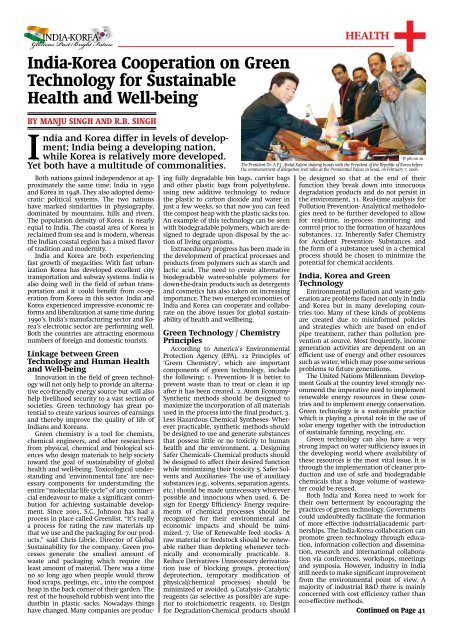INDIA-KOREA - Asia-Pacific Business and Technology Report
INDIA-KOREA - Asia-Pacific Business and Technology Report
INDIA-KOREA - Asia-Pacific Business and Technology Report
You also want an ePaper? Increase the reach of your titles
YUMPU automatically turns print PDFs into web optimized ePapers that Google loves.
<strong>INDIA</strong>-<strong>KOREA</strong><br />
Glorious Past Bright Future<br />
India-Korea Cooperation on Green<br />
<strong>Technology</strong> for Sustainable<br />
Health <strong>and</strong> Well-being<br />
by Manju singh <strong>and</strong> R.B. Singh<br />
India <strong>and</strong> Korea differ in levels of development;<br />
India being a developing nation,<br />
while Korea is relatively more developed.<br />
Yet both have a multitude of commonalities.<br />
Both nations gained independence at approximately<br />
the same time; India in 1950<br />
<strong>and</strong> Korea in 1948. They also adopted democratic<br />
political systems. The two nations<br />
have marked similarities in physiography,<br />
dominated by mountains, hills <strong>and</strong> rivers.<br />
The population density of Korea is nearly<br />
equal to India. The coastal area of Korea is<br />
reclaimed from sea <strong>and</strong> is modern, whereas<br />
the Indian coastal region has a mixed flavor<br />
of tradition <strong>and</strong> modernity.<br />
India <strong>and</strong> Korea are both experiencing<br />
fast growth of megacities. With fast urbanization<br />
Korea has developed excellent city<br />
transportation <strong>and</strong> subway systems. India is<br />
also doing well in the field of urban transportation<br />
<strong>and</strong> it could benefit from co-operation<br />
from Korea in this sector. India <strong>and</strong><br />
Korea experienced impressive economic reforms<br />
<strong>and</strong> liberalization at same time during<br />
1990’s. India’s manufacturing sector <strong>and</strong> Korea’s<br />
electronic sector are performing well.<br />
Both the countries are attracting enormous<br />
numbers of foreign <strong>and</strong> domestic tourists.<br />
Linkage between Green<br />
<strong>Technology</strong> <strong>and</strong> Human Health<br />
<strong>and</strong> Well-being<br />
Innovation in the field of green technology<br />
will not only help to provide an alternative<br />
eco-friendly energy source but will also<br />
help livelihood security to a vast section of<br />
societies. Green technology has great potential<br />
to create various sources of earnings<br />
<strong>and</strong> thereby improve the quality of life of<br />
Indians <strong>and</strong> Koreans.<br />
Green chemistry is a tool for chemists,<br />
chemical engineers, <strong>and</strong> other researchers<br />
from physical, chemical <strong>and</strong> biological sciences<br />
who design materials to help society<br />
toward the goal of sustainability of global<br />
health <strong>and</strong> well-being. Toxicological underst<strong>and</strong>ing<br />
<strong>and</strong> ‘environmental fate’ are necessary<br />
components for underst<strong>and</strong>ing the<br />
entire “molecular life cycle” of any commercial<br />
endeavour to make a significant contribution<br />
for achieving sustainable development.<br />
Since 2001, S.C. Johnson has had a<br />
process in place called Greenlist. “It’s really<br />
a process for rating the raw materials up<br />
that we use <strong>and</strong> the packaging for our products,”<br />
said Chris Librie, Director of Global<br />
Sustainability for the company. Green processes<br />
generate the smallest amount of<br />
waste <strong>and</strong> packaging which require the<br />
least amount of material. There was a time<br />
no so long ago when people would throw<br />
food scraps, peelings, etc., into the compost<br />
heap in the back corner of their garden. The<br />
rest of the household rubbish went into the<br />
dustbin in plastic sacks. Nowadays things<br />
have changed. Many companies are producing<br />
fully degradable bin bags, carrier bags<br />
<strong>and</strong> other plastic bags from polyethylene,<br />
using new additive technology to reduce<br />
the plastic to carbon dioxide <strong>and</strong> water in<br />
just a few weeks, so that now you can feed<br />
the compost heap with the plastic sacks too.<br />
An example of this technology can be seen<br />
with biodegradable polymers, which are designed<br />
to degrade upon disposal by the action<br />
of living organisms.<br />
Extraordinary progress has been made in<br />
the development of practical processes <strong>and</strong><br />
products from polymers such as starch <strong>and</strong><br />
lactic acid. The need to create alternative<br />
biodegradable water-soluble polymers for<br />
down-the-drain products such as detergents<br />
<strong>and</strong> cosmetics has also taken on increasing<br />
importance. The two emerged economies of<br />
India <strong>and</strong> Korea can cooperate <strong>and</strong> collaborate<br />
on the above issues for global sustainability<br />
of health <strong>and</strong> wellbeing.<br />
Green <strong>Technology</strong> / Chemistry<br />
Principles<br />
According to America’s Environmental<br />
Protection Agency (EPA), 12 Principles of<br />
‘Green Chemistry’, which are important<br />
components of green technology, include<br />
the following: 1. Prevention- It is better to<br />
prevent waste than to treat or clean it up<br />
after it has been created. 2. Atom Economy-<br />
Synthetic methods should be designed to<br />
maximize the incorporation of all materials<br />
used in the process into the final product. 3.<br />
Less Hazardous Chemical Syntheses- Wherever<br />
practicable, synthetic methods should<br />
be designed to use <strong>and</strong> generate substances<br />
that possess little or no toxicity to human<br />
health <strong>and</strong> the environment. 4. Designing<br />
Safer Chemicals- Chemical products should<br />
be designed to affect their desired function<br />
while minimizing their toxicity 5. Safer Solvents<br />
<strong>and</strong> Auxiliaries- The use of auxiliary<br />
substances (e.g., solvents, separation agents,<br />
etc.) should be made unnecessary wherever<br />
possible <strong>and</strong> innocuous when used. 6. Design<br />
for Energy Efficiency- Energy requirements<br />
of chemical processes should be<br />
recognized for their environmental <strong>and</strong><br />
economic impacts <strong>and</strong> should be minimized.<br />
7. Use of Renewable feed stocks- A<br />
raw material or feedstock should be renewable<br />
rather than depleting whenever technically<br />
<strong>and</strong> economically practicable. 8.<br />
Reduce Derivatives- Unnecessary derivatization<br />
(use of blocking groups, protection/<br />
deprotection, temporary modification of<br />
physical/chemical processes) should be<br />
minimized or avoided. 9.Catalysis- Catalytic<br />
reagents (as selective as possible) are superior<br />
to stoichiometric reagents, 10. Design<br />
for Degradation-Chemical products should<br />
health<br />
© pib.nic.in<br />
The President Dr. A.P.J. Abdul Kalam shaking h<strong>and</strong>s with the President of the Republic of Korea before<br />
the commencement of delegation level talks at the Presidential Palace in Seoul, on February 7, 2006.<br />
be designed so that at the end of their<br />
function they break down into innocuous<br />
degradation products <strong>and</strong> do not persist in<br />
the environment, 11. Real-time analysis for<br />
Pollution Prevention- Analytical methodologies<br />
need to be further developed to allow<br />
for real-time, in-process monitoring <strong>and</strong><br />
control prior to the formation of hazardous<br />
substances, 12. Inherently Safer Chemistry<br />
for Accident Prevention- Substances <strong>and</strong><br />
the form of a substance used in a chemical<br />
process should be chosen to minimize the<br />
potential for chemical accidents.<br />
India, Korea <strong>and</strong> Green<br />
<strong>Technology</strong><br />
Environmental pollution <strong>and</strong> waste generation<br />
are problems faced not only in India<br />
<strong>and</strong> Korea but in many developing countries<br />
too. Many of these kinds of problems<br />
are created due to misinformed policies<br />
<strong>and</strong> strategies which are based on end-of<br />
pipe treatment, rather than pollution prevention<br />
at source. Most frequently, income<br />
generation activities are dependent on an<br />
efficient use of energy <strong>and</strong> other resources<br />
such as water, which may pose some serious<br />
problems to future generations.<br />
The United Nations Millennium Development<br />
Goals at the country level strongly recommend<br />
the imperative need to implement<br />
renewable energy resources in these countries<br />
<strong>and</strong> to implement energy conservation.<br />
Green technology is a sustainable practice<br />
which is playing a pivotal role in the use of<br />
solar energy together with the introduction<br />
of sustainable farming, recycling, etc.<br />
Green technology can also have a very<br />
strong impact on water sufficiency issues in<br />
the developing world where availability of<br />
these resources is the most vital issue. It is<br />
through the implementation of cleaner production<br />
<strong>and</strong> use of safe <strong>and</strong> biodegradable<br />
chemicals that a huge volume of wastewater<br />
could be reused.<br />
Both India <strong>and</strong> Korea need to work for<br />
their own betterment by encouraging the<br />
practices of green technology. Governments<br />
could undoubtedly facilitate the formation<br />
of more effective industrial/academic partnerships.<br />
The India-Korea collaboration can<br />
promote green technology through education,<br />
information collection <strong>and</strong> dissemination,<br />
research <strong>and</strong> international collaboration<br />
via conferences, workshops, meetings<br />
<strong>and</strong> symposia. However, industry in India<br />
still needs to make significant improvement<br />
from the environmental point of view. A<br />
majority of industrial R&D there is mainly<br />
concerned with cost efficiency rather than<br />
eco-effective methods.<br />
Continued on Page 41









